Cyperus blepharoleptos
| Cyperus blepharoleptos | |
|---|---|

| |
| Scientific classification | |
| Kingdom: | Plantae |
| Clade: | Tracheophytes |
| Clade: | Angiosperms |
| Clade: | Monocots |
| Clade: | Commelinids |
| Order: | Poales |
| Family: | Cyperaceae |
| Genus: | Cyperus |
| Species: | C. blepharoleptos
|
| Binomial name | |
| Cyperus blepharoleptos | |
| Synonyms | |
| |
Cyperus blepharoleptos is a sedge of the family Cyperaceae that is native to the Americas, Caribbean Islands, and Africa.[1][2] A common name for this species is Cuban bulrush.[3]
This species of Cyperus was named by German physician and amateur botanist, Ernst Gottlieb von Steudel, in 1854.[4]

It grows to a height of 0.30–0.91 m (1–3 ft). Its stems are sharply triangular and smooth and the leaves grow from the base of the plant. The leaves are narrow and ribbon-like; 6.4 mm (0.25 in) wide and 0.91–1.22 m (3–4 ft) in length, with the leaves often longer than the stem. The inflorescence occurs at the top of the stem. Each stalk is topped by a dense, spherical head, about 19 mm (0.75 in) in diameter. The heads containing numerous reddish-brown spikelets, which are spiral and overlapping. The fruit is an olive nutlet about 20 mm (0.8 in) in length.
See also
References
- ^ "Cyperus blepharoleptos Steud". www.gbif.org. Retrieved 2023-03-24.
- ^ "Cyperus blepharoleptos Steud. | Plants of the World Online | Kew Science".
- ^ "Cyperus blepharoleptos - Species Details".
- ^ "Cyperus blepharoleptos Steud".